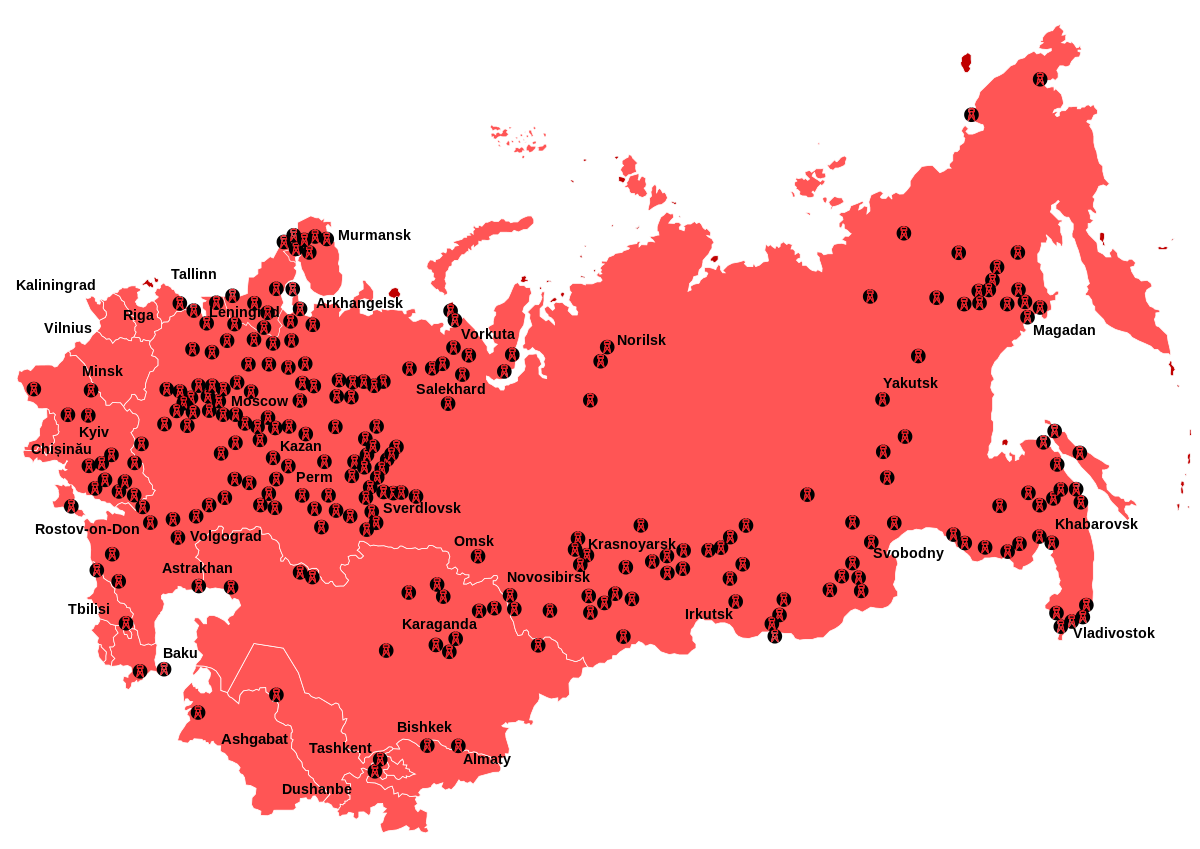The Gulag was a government agency created by Vladimir Lenin which became more infamously known as the Soviet forced labor camp system during Joseph Stalin's rule from the 1930s-1950s. Gulag is actually an acronym for "Main Administration of Corrective Labor Camps". In the camp were a wide range of convicts, from petty criminals to political prisoners. The Gulag is recognized as a major instrument of political repression in the Soviet Union. Between 1934 and 1953 over one million prisoners died within these camps.
| Prisoners work at Belbaltlag, a Gulag camp for building the White Sea-Baltic Sea |
The GULAG was originally created as an administration body that watched over the camps; eventually Gulag became used as a name for the camps themselves. After Lenin's death in 1924, Stalin was able to take control of the government, and began to form his own version of the gulag system. On June 27, 1929 the Politburo (highest policy-making government authority) created a system of self-supporting camps that would eventually replace the existing prisons around the country. These prisons were meant to receive inmates that had a prison sentence that exceeded 3 years. Prisoners that had a shorter prison sentence than 3 years were to remain in the prison system that was still under the control of the NKVD (group that oversaw prison and labor camps at the time). The purpose of these new camps was to colonize the remote and inhospitable environments throughout the Soviet Union. However what should also be noted is that these changes took place around the same time that Stalin started to institute rapid industrial development in Soviet Russia.
 |
| Locations of Gulags throughout Soviet Russia |
The end of the Gulags cannot really be indentified as one particular day in history but on March 5, 1953 Stalin died and they were all distributed to high ranking Soviets immediately. On March 26, Lavrentiy Beria (a soviet politician) sent the Presidium of the Central Committee a proposed decree “on amnesty.” This decree called for the release of about one million inmates from Gulag camps. The next day the amnesty decree was published in the press, and over the next 3 months some 1.5 million prisoners, or about 60% of the entire Gulag population, was released.
Sources:
http://gulaghistory.org/nps/onlineexhibit/stalin/work.php
https://en.wikipedia.org/wiki/Gulag
https://www.hoover.org/sites/default/files/uploads/documents/0817939423_67.pdf
Interesting post, Belen! I thought that it was especially fascinating how gulags were made to colonize the inhospitable areas of Russia. I was researching this a bit online and I actually found out that gulags generally did not contain the large populations of rapists, murderers, and drug dealers of today’s prisons. The vast majority were political prisoners, intellectuals who took a stand against the government’s oppressive regime. They were arrested under Article 38, a sweeping penal code that called for the arrest of anyone suspected of counter-revolution. In May of 1954, there was an uprising at a gulag in the Kazakh SSR, and the prisoners took control of the camp, driving out the guards. The inmates took full advantage of their freedom, building their own society complete with wedding ceremonies, plays, and an improvised hydroelectric power system. Knowing that they couldn’t hold the gulag for long without defending themselves, they made all kinds of weapons, including crude IEDs. 40 days into their uprising, the Red Army stormed in with tanks, attack dogs, and 1,700 troops. The prisoners put up a valiant fight, but their rebellion was crushed. Some of the defeated inmates committed suicide, fearing what might happen to them if they were caught. The official government death toll numbers mere dozens, but survivors reported that hundreds were killed.
ReplyDeletehttp://soviethistory.msu.edu/1954-2/prisoners-return/prisoners-return-texts/the-forty-days-of-kengir/
Cool post, Belen! I enjoyed learning more about the gulags and how they were integral for the Soviet regime to maintain control over the people. As Elise said above, I also read about how many of the prisoners who were in the Gulag camps were those who were threatening to the safety of the communist government. Intellectuals were some of the biggest threats to the regime's stability. Interestingly enough, Stalin is infamous for sending the wife of his son Yakov, to a concentration camp. Julia, separated from her three year old daughter, was a Jewish girl married to Yakov and was sent to live in a Gulag after he was captured in battle. According to the article, "Stalin considered all prisoners as traitors to the motherland and those that surrendered he demonised as ‘malicious deserters'."- a definition that extended to his own son. This event was used for propaganda against the harshness and brutal nature of the communist government. Stalin was willing to send his own daughter-in law to a work camp; something she was never able to recover from.
ReplyDeletehttp://www.historyinanhour.com/2011/12/04/the-sad-lives-and-demise-of-stalin%E2%80%99s-sons/